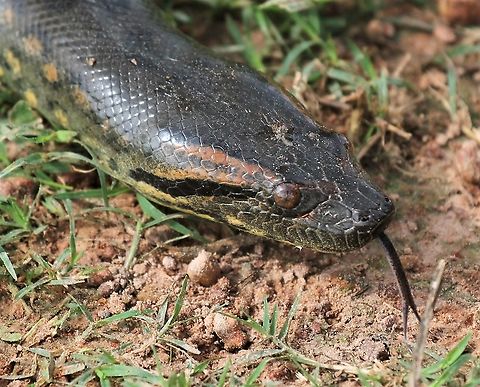
Naming
Common names for ''Eunectes murinus'' include Green Anaconda, Anaconda, Common Anaconda and Water Boa.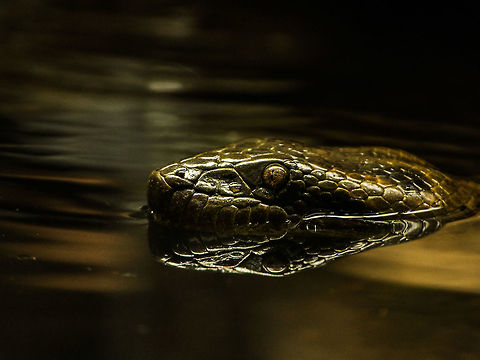
Behavior
The primarily nocturnal anaconda species tend to spend most of its life in or around water. Anacondas are also sometimes known as the "Water Boa"; they spend more time in water than any of the boas. Because of their large size, they appear rather slow and sluggish when traveling on land. Completely the opposite in water, however, anacondas are known to have the potential to reach high speeds in all depths of water. They tend to float atop the surface of the water with the snout barely poking out above the surface. When prey passes by or stops to drink, a hungry anaconda will snatch it with its jaws and coil around it with its body. The snake will then constrict until it has successfully suffocated the prey.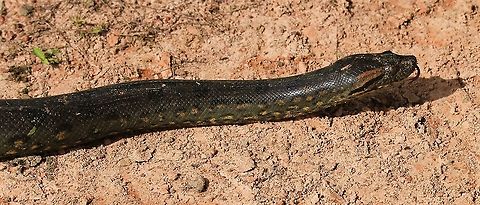
Habitat
One may reasonably maintain an average and acceptable temperature for the snake by the use of a heating element or infra-red light bulbs. A gradient must be offered within the enclosure to allow the snake to bask in the heat or go to cooler areas in the tank. Optimum humidity can be difficult to maintain and research must be done on the snake to determine the correct level. Less than 80% humidity must be maintained for caging an anaconda species from the tropical region, while a slightly less than 30% humidity must be maintained for a species of a desert region. Photo periods are often used with most species of snake; natural light is best for this, but Low % UV bulbs can also be used.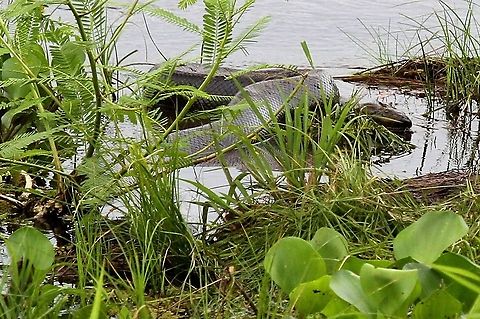
Reproduction
This species is solitary until the mating season, which occurs during the rainy season, and can last for several months, usually from April to May. During this time, males must find females. Typically, female snakes will lay down a trail of pheromones for the males to follow, but it is still unclear how the males of this species track a female's scent. Another possibility is that the female releases an airborne stimulant. This theory is supported by the observation of females that remain motionless while many males move towards them from all directions. Male anacondas also frequently flick their tongues to sense chemicals that signal the presence of the female.In any case, many males often find the same female. Although it may not be necessary for there to be more than one male, this results in odd clusters, referred to as "breeding balls," in which up to 12 males wrap around the same female and attempt to copulate. The group could stay in this position from 2–4 weeks. This ball acts as a slow-motion wrestling match between the males, each one fighting for the opportunity to mate with the female.
During mating, males make use of their spurs to arouse the female. They aggressively press their cloacal regions hard against the female body while continuously scratching her with their spurs. This can produce a scratching sound. Mating approaches its climax when the stimulus of the males' spurs induce the female snake to raise her cloacal region, allowing the cloacae of the two snakes to move together. The male then coils his tail, surrounding the female and they copulate. The strongest and largest male is often the victor. However, females are physically much larger and stronger and may decide to choose from among the males. Courtship and mating occur almost exclusively in water.
Mating is followed by a gestation period that lasts approximately 6–7 months. The species is ovoviviparous, with females giving birth to live young. Litters usually consists of 20–40 offspring, although as many as 100 may be produced. After giving birth, females may lose up to half their weight.
Neonates are around 70–80 cm long and receive no parental care. Because of their small size, they often fall prey to other animals. Should they survive, they grow rapidly until they reach sexual maturity in their first few years, after which their rate of growth continues at a slower pace.
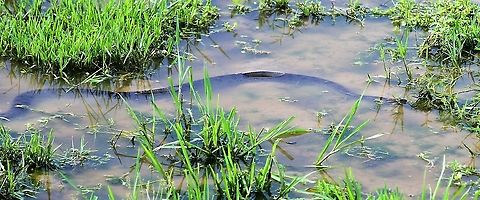
Food
Primarily aquatic, they eat a wide variety of prey, almost anything they can manage to overpower, including fish, birds, a variety of mammals, and other reptiles. Particularly large anacondas may even consume large prey such as tapir, deer, capybara and caiman, but such large meals are not regularly consumed. There are many local stories and legends regarding the anaconda as a man-eater, but there is very little evidence to support any such activity. They employ constriction to subdue their prey. Cannibalism among green anacondas is also known, most recorded cases involving a larger female consuming a smaller male. While the exact reason for this is not understood, scientists cite several possibilities, including the dramatic sexual dimorphism in the species, and the possibility that a female anaconda requires additional food intake after breeding to sustain the long period of gestation. The nearby male simply provides the opportunistic female a ready source of nutrition.References:
Some text fragments are auto parsed from Wikipedia.